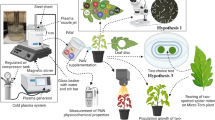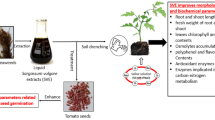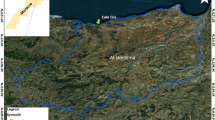Abstract
The tomato leaf miner, Tuta absoluta (Meyrick), is the most important pest for tomato production in Iran. The effect of flubendiamide and thiocyclam hydrogen oxalate insecticides was assessed on cellular energy allocation (CEA) of the third instar larvae of T. absoluta ingesting six different tomato cultivars. Plant leaves were treated with LC50 concentration of both insecticides and their energy available (Ea), energy consumption (Ec), and CEA were calculated. The results showed that total energy reserves (protein, carbohydrate, and lipid budgets) were significantly reduced after exposure to insecticides and tomato secondary metabolites. The larvae fed on Riogrande and Super Chief cultivars showed the least amount of energy available after treatment with both insecticides. The highest rate of oxygen consumption was observed in larvae fed on Calj, Super Luna, and Super strain B after treatment with flubendiamide. The amount of CEA decreased in treated larvae compared to untreated larvae. This reduction was statistically higher in treated larvae that fed on Riogrande and Super strain B cultivars. Reduction in CEA is probably due to the expenses of dealing with detoxification of insecticides and plant metabolites. CEA is a suitable and primary biomarker for the effects of cultivars and insecticides as integrate and summarizes insect energy allocation in variable situations.




Similar content being viewed by others
References
Babu PRA, Reddy GR, Babu GRV, Chetty CS (1988) Glycolitic oxidation in freshwater fish, Sarotherodon mossambicus during benthiocarb exposure. Curr Sci 57(11):591–594
Bagheri F, Talebi KH, Hosseininaveh V (2010) Cellular energy allocation of pistachio green stink bug, Brachynema germari Kol. (Hemiptera: Pentatomidae) in relation to juvenoid pyriproxyfen. Afr J Biotechnol 9(35):5746–5753
Baniameri V, Cheraghian A (2012) The first report and control strategies of Tuta absoluta in Iran. Bulletin OEPP/EPPO Bulletin 42(2):322–324
Bizhannia AR, Etebari K, Sorati R (2005) The effects of a juvenile hormone analog, Admiral®, application on protein metabolism of silkworm, Bombyx mori (Lep.: Bombycidae). J Entomol Soc Iran 25(1):43–55
Bradford M (1976) A rapid and sensitive method for quantitation of microgram quantities of protein utilizing the principle of protein-dye binding. Anal Biochem 72(72):248–254
Calow P (1991) Physiological costs of combating chemical toxicants: ecological implications. Comp Biochem Physiol C 100:3–6
Calow P, Sibly R (1990) A physiological basis of population processes: ecotoxicological implications? Funct Ecol 4(3):283–288
De Coen WM, Janssen CR (1997) The use of biomarkers in Daphnia magna toxicity. Cellular energy allocation: a new methodology to assess the energy budget of toxicant-stressed Daphnia populations. J Aquat Ecosyst Stress Recovery 6(1):43–55
De Coen WM, Janssen CR (2003) The missing biomarker link: relationships between effects on the cellular energy allocation biomarker of toxicant-stressed Daphnia magna and corresponding population characteristics. Env Toxicol Chem 22:1632–1641
Downer RG, Matthews JR (1976) Patterns of lipid storage and utilization in insects. Am. Zool. 16(4):733–745
Erk M, Ivanković D, Strižak Ž (2011) Cellular energy allocation in mussels (Mytilus galloprovincialis) from the stratified estuary as a physiological biomarker. Mar. Pollut. Bull. 62:1124–1129
Etebari K, Matindoost L (2004) The study on effects of larval age and starvation stress on biochemical macromolecules abundance of haemolymph in silkworm Bombyx mori. In Proceedings of the Sixteenth Iranian Plant Protection Congress, General Entomology Symposium, August 28–September 1 University of Tabriz Iran. pp 435
Etebari K, Bizhannia AR, Sorati R, Matindoost L (2007) Biochemical changes in haemolymph of silkworm larvae due to pyriproxyfen residue. Pestic. Biochem. Physiol. 88:14–19
Gamil WE, Mariy FM, Youssef LA, Abdel Halim SM (2011) Effect of indoxacarb on some biological and biochemical aspects of Spodoptera littoralis (Boisd.) larvae. An Agric Sci 56:121–126
Gholamzadeh Chitgar M, Hajizadeh J, Ghadamyari M, Karimi A, Sharifi M, Hoda H (2014) Cellular energy allocation in the predatory bug, Andrallus spinidens Fabricius (Hemiptera: Pentatomidae), following sublethal exposure to diazinon, fenitrothion, and chlorpyrifos. J Plant Protect Res 54(1):78–84
Gomes SIL, Scott-Fordsmand JJ, Amorim MJB (2015) Cellular energy allocation to assess the impact of nanomaterials on soil invertebrates (Enchytraeids): the effect of Cu and Ag. Int J Environ Res Public Health 12:6858–6878
Harper HA, Rodwell VM, Mayer PA (1979) Review of physiological chemistry, Longe Medical Publications. Maruzer Company limited, California, p 702
Hodjat SH (2016) Effects of crowding and stress on locusts, aphids, armyworms and specifically the hemipteran Dysdercus fasciatus Sign. (Hemiptera: Pyrrhocoridae). J Crop Prot 5(3):313–329
Hussain R, Ashfaq M, Saleem MA (2009) Biochemical abnormalities produced by spinosad in Tribolium castaneum adult beetles. Int J Agric Biol 11:241–244
Jabakumar SRD, Jayaraman FAZ (1988) Changes in protein, lipid and carbohydrate content in fresh water fish, Lepidocephalicythys thermalis during short-term sublethal exposure of malathion. Ann Zool 26(1):82–89
Jain R, Ahi J, Rai S, Jain N (2011) N-nitroso-N-methylurea induced changes in protein level of ovary and fatbody of the insect Periplaneta americana. Asian J Exp Biol Sci 2(3):533–536
King F, Packard TT (1975) Respiration and the activity of the respiratory electron transport system in marine zooplankton. Limnol Oceanogr 20:849–854
Mandal D, Chaudhuri DK (1992) Studies on carbohydrate, protein and lipid levels in normal and stress conditions in fat body and integument as compared to whole body during development of moth Corcyra cephalonica. Int J Trop Insect Sci 13:121–128
Marron MT, Markow TA, Kain KJ, Gibbs AG (2003) Effects of starvation and desiccation on energy metabolism in desert and mesic Drosophila. J Insect Physiol 49(3):261–270
McKenney CL (1998) Physiological dysfunction in estuarine mysids and larval decapods with chronic pesticide exposure. In: Wells PG, Blaise C (eds) Microscale Testing in Aquatic Toxicology: Advances, Techniques, and Practice. CRC Press, Boca Raton, p 720
Mello MO, Silva-Filho MC (2002) Plant-insect interactions: an evolutionary arms race between two distinct defense mechanisms. Braz. J Plant Physiol. 14(2):71–81
Memarizadeh N, Ghadamyari M, Adeli M, Talebi K (2014) Biochemical biomarkers of Glyphodes pyloalis Walker (Lepidoptera: Pyralidae) in exposure to TiO2 nanoparticles. Invertebr Survival J 11:47–53
Mohammadzadeh Tamam B, Ghadamyari M, Sahragard A, Karimi-Malati A (2014) Sublethal effects of Spinosad on some biochemical parameters of Xanthogaleruca luteola (Müller) (Coleoptera: Chrysomelidae). Plant Protect Sci 50(4):199–206
Nath BS (2000) Changes in carbohydrate metabolism in hemolymph and fat body of the silkworm, Bombyx mori L. exposed to organophosphorus insecticides. Pestic Biochem Physiol 68(3):127
Novais SC, Amorim MJB (2013) Changes in cellular energy allocation in Enchytraeus albidus when exposed to dimethoate, atrazine, and carbendazim. Environ Toxicol Chem 32:2800–2807
Novais SC, Soares AMVM, de Coen W, Amorim MJB (2013) Exposure of Enchytraeus albidus to Cd and Zn-Changes in cellular energy allocation (CEA) and linkage to transcriptional, enzymatic and reproductive effects. Chemosphere 90:1305–1309
Oberdorster E, Rittschof D, McClellan-Green P (1998) Induction of cytochrome P450 3A and heat shock protein by tributyltin in blue crab, Callinectes sapidus. Aqu Toxicol 41:83–100
Retta AN, Berhe DH (2015) Tomato leaf miner–Tuta absoluta (Meyrick), a devastating pest of tomatoes in the highlands of Northern Ethiopia: a call for attention and action. Res J Agric Environ Manag 4(6):264–269
SAS Institute (2002) SAS/STAT user’s guide. SAS Institute Inc, Cary, NC Inc
Shoba V, Elanchezhiyan C, Hemalatha S, Selvisabanayakam S (2011) Sublethal effect of phytopesticide nimbecidine on biochemical changes in the adult male insect Sphaerodema rusticum (Heteroptera: Belostomatidae). Int J Res Pharm Sci 2(1):12–17
Smith RL, Hargreaves BR (1984) Oxygen consumption in Neomysis americana (Crustacea: Mysidacea) and the effects of naphthalene exposure. Mar Biol 79(2):109–116
Smolders R, Bervoets L, De Coen W, Blust R (2004) Cellular energy allocation in zebra mussels exposed along a pollution gradient: Linking cellular effects to higher levels of biological organization. Environ Pollut 129:99–112
Srinivas P (1986) Studies on metabolic stress in silk moth, Bombyx mori (L) induced by selective insecticides. PhD. Thesis, Kakatiya University, Warangal, India.
Thunberg LV, Manchester KL (1972) Effect of denervation on the glycogen content and on the activities of enzyme glucose and glycogen metabolism in rat diaphragm muscle. Biol J 128(4):128–789
van Handel E, Day J (1988) Assay of lipids, glycogen and sugars in individual mosquitoes: correlations with wing length in field collected Aedes vexans. J Am Mosq Control Assoc 4:549–550
Verslycke T, Janssen CR (2002) Effects of a changing abiotic environment on the energy metabolism in the estuarine mysid shrimp Neomysis integer (Crustacea: Mysidacea). J Exp Mar Biol Ecol 279:61–72
Verslycke T, Roast SD, Widdows J, Jones MB, Janssen CR (2004) Cellular energy allocation and scope for growth in the estuarine mysid Neomysis integer (Crustaycea: Mysidacea) following chlorpyrifos exposure: a method comparison. Exp Marine Biol Ecol J 360:1–16
Watanabe M, Tanaka K (2000) Hormonal control of diapause and overwintering traits in a leaf beetle, Aulacophora nigripennis. Physiol Entomol 25:337–345
Yuval B, Kaspi R, Shloush S, Warburg MS (1998) Nutritional reserves regulate male participation in Mediterranean fruit fly leks. Ecol Entomol 23:211–215
Ziegler R (1991) Changes in lipid and carbohydrate metabolism during starvation in adult Manduca sexta. J Comp Physiol B 161:125–131
Acknowledgements
This research was supported financially by Urmia University as a part of the first author Ph.D. thesis that is acknowledged hereby. We appreciate University of Guilan for providing laboratory for biochemical experiments.
Author information
Authors and Affiliations
Contributions
FSN conducted bioassays and biochemical experiments; designed the figures and tables, and statistical analysis; and wrote the manuscript draft. SAS supervised all experimental setups and assisted in statistical analysis and writing the manuscript. MG advised in the experimental setups and afforded facilities for biochemical experiments. VHN participated during the original design of the study and advised in the experimental setups.
Corresponding author
Additional information
Edited by Pedro Takao Yamamoto
Publisher’s Note
Springer Nature remains neutral with regard to jurisdictional claims in published maps and institutional affiliations.
Rights and permissions
About this article
Cite this article
Sadeghi Nasab, F., Safavi, S.A., Ghadamyari, M. et al. Cellular Energy Allocation of Tuta absoluta (Lepidoptera: Gelechiidae) treated with Flubendiamide and Thiocyclam Hydrogen Oxalate on Different Tomato Cultivars. Neotrop Entomol 50, 398–407 (2021). https://doi.org/10.1007/s13744-021-00856-4
Received:
Accepted:
Published:
Issue Date:
DOI: https://doi.org/10.1007/s13744-021-00856-4




